Grand Chorus Without End at the Old Cathedral in Jackson Square
Every quarter-hour, the thin peal of bells at St. Louis Cathedral calls saints and sinners, mostly the latter. They clang out a slightly off-key sound, as if they well know the offbeat rhythms of the neighborhood below them. The pulse of a circus atmosphere around the church pounds from hour to hour, as if to compete with the timbre of the sounds from the tower. The church stands sentinel, nether judging nor joining.
Inside, the aroma of ancient brick masonry greets the visitor. One thinks at once of an old French monastery, although stone is nowhere. The darkened entry gives way to a bright interior with painted surfaces everywhere. The eye is drawn to the great high Rococo altar, where gilded and fluted columns of the Corinthian order support a busy entablature. Two rows of wooden columns divide the church into nave and side aisles, with a mute upper gallery where, one imagines, crowds overflowed before Vatican II put an end to crowded churches.
Along the walls, St. Louis lives through stages in multicolored shards of artist’s glass and lead. Here he receives a blessing from St Blanche, his mother; there he marries. He builds a chapel, receives the crown of France, and departs for his first crusade across a wooden plank. Further on he visits a leper with lesions of hollow glass, and in the great lunette over the high altar Louis announces the Seventh Crusade. Overhead, St. Peter receives his shepherd’s staff from the Savior, surrounded by apostles, as the Father oversees the mission.
St. Louis Cathedral Gallery
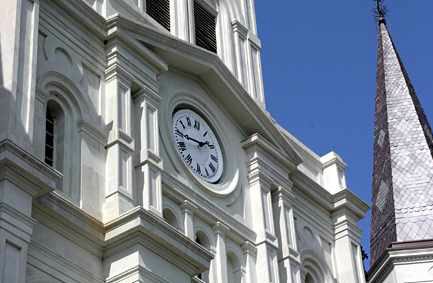
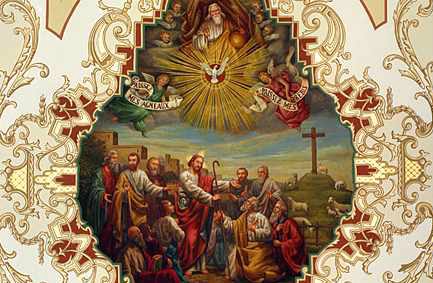
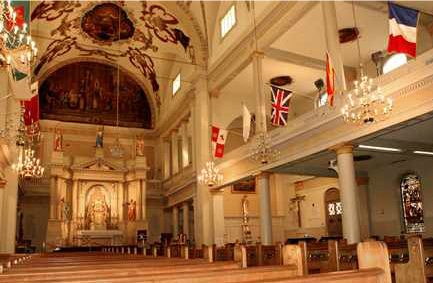
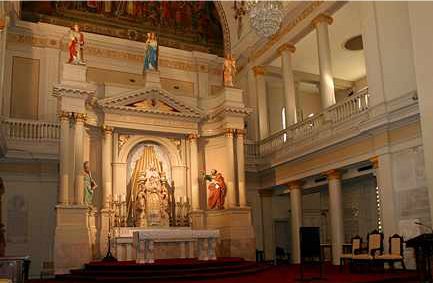
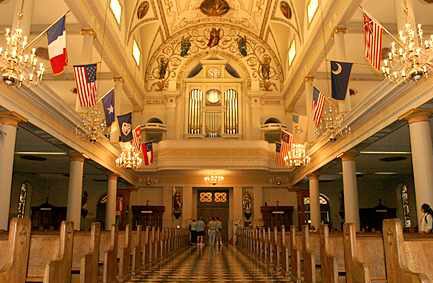
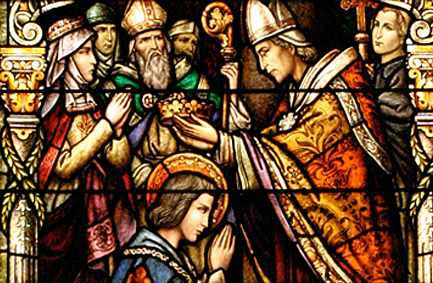
Pere Antoine, Bishops’ Bones, Unending Restoration
History, harmony, legend, and tradition preserve the mystique of this cathedral. By most counts it is the third substantial church of St. Louis on the square. The French built the first one in 1727, following the town plan. It stood, weathered, until the Great Fire of 1788, when Spanish dons were ruling. Rebuilt with funds from local notary and real estate developer Andres Almonester y Rojas, the second church barely escaped the flames of yet another general fire in 1794. It was mainly in that second church that the memorable Spanish Capuchin Pere Antonio of Sedella served from 1783 until his much-lamented death in 1829. Here lay the bones of old Don Almonster, and of the said Friar Antonio, for whom the people named Pere Antoine’s Alley alongside the church. Here was sung the Te Deum thanking God for the Victory of the Battle of New Orleans in 1815.
The Spanish church got its stripes when the city received its first bishop in 1793. Sixty years later, New Orleans became an archbishopric, elevating the cathedral further. The present building rose then, incorporating a few bricks and lines of mortar from its predecessor. The marguilliers or church wardens had it built from plans drawn in 1849 by French-born architect Jacques N. B. de Pouilly. Its iconic, multi-stage, tapering, slate-covered triple towers are better than any that preceded it.
Today the church contains the remains of eight New Orleans bishops. Their lives reflect the story of the Church and the city. Renovated, decorated and restored over and again, repainted inside and out, waterproofed, strengthened with steel, buttresses added, foundations fixed, the church stands. Today the St. Louis Cathedral is a symbol of New Orleans and a tribute to the people and clergy who have struggled to preserve it. Most of all it is a haven of serenity from the soul-splitting life of the world outside.
Sally Reeves is a noted writer and historian who co-authored the award winning series New Orleans Architecture. She also has written Jacques-Felix Lelièvre’s New Louisiana Gardener and Grand Isle of the Gulf – An Early History. She is currently working on a social and architectural history of New Orleans public markets and on a book on the contributions of free persons of color to vernacular architecture in antebellum New Orleans.





